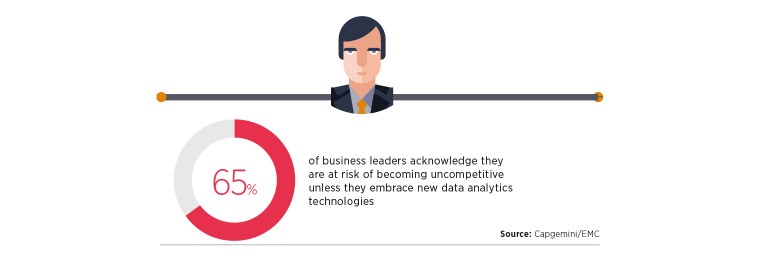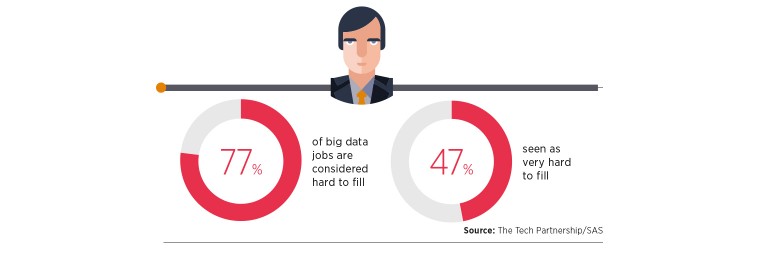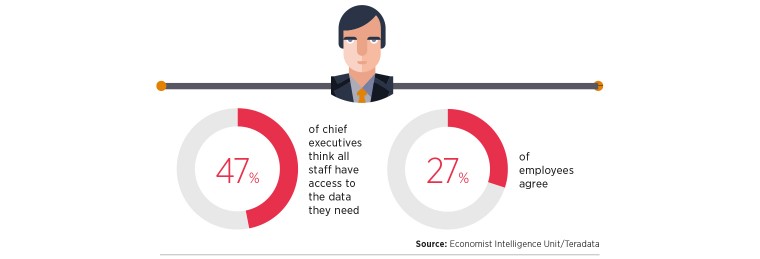It is easy to understand why some employees are suspicious of big data. While executives continue to hype the term to almost cacophonous levels, there is a dearth of evidence to prove the business benefits of costly technology implementations.
Research by the Economist Intelligence Unit suggests many companies have invested significantly in gathering vast amounts of data. Yet 57 per cent of employees believe their organisation does a poor job of capturing and disseminating important business data.
To allay employee fears and to help create the information that can produce a competitive advantage, business leaders must focus on embedding a data culture within the company. But how can executives create a data-driven organisation?
The answer, according to industry experts, is to find senior organisational support for initiatives and to demonstrate the long-term value of an initiative. The starting point must be to convince suspicious employees that big data can have a positive impact on the nature of work.
Jon Cooke, a member of cross-industry body the Data Innovation Working Group, was recently involved with a big data implementation at an investment bank. Operations staff at the bank, who dealt with issues such as settlements, reconciliations and reporting, were concerned they were about to be replaced by a management information system.
“The point to make is that technology should empower rather than replace people,” says Mr Cooke, who is also head of the data science practice at GFT. “Rather than having to spend time trawling through data to find the answer to questions relating to trades, the operations staff at the bank can ask direct questions through the big data platform and find immediate answers for the board or the regulator.”
Business leaders, then, must demonstrate how big data tools are not necessarily a like-for-like replacement for staff. In fact, former Tullow Oil chief information officer Andrew Marks says it is important to recognise that the rise of big data does not have to mean a set of long-standing job roles are on the way out.
“Show me the examples where jobs have been destroyed as a result of using big data,” he says. “What will happen is that we will all become better skilled at using data and people will be employed in different jobs. And there are already examples of where the use of big data is helping to push demand for people.”
There is one problem – it can be difficult to find highly qualified analytics experts
Industry evidence suggests Mr Marks is correct. Demand for big data specialists is set to rise 160 per cent between 2013 and 2020, according to The Tech Partnership. The IT industry body estimates there will be around 56,000 job opportunities a year for big data specialists by the end of the decade.
Companies are, therefore, making more use of data and this trend is only likely to continue. Take Abi Somorin, senior IT manager at beachwear retailer Orlebar Brown, who says benchmarking data – in terms of customer trends and competitor sales – can be hugely valuable.
“We need to be aware of how product lines perform, both by time of year and across specific regions,” he says. “Every part of our business, such as sales, production and finance, will look at that data in a slightly different way. There’s an ever-changing demand for analytics, and it’s something I must always consider in terms of technology and resources.”
Smart business leaders, such as Mr Somorin, recognise the importance of big data and work hard to win the trust of reticent employees. By employing big data specialists, companies can gain new insights that boost worker productivity. There is, however, one problem – it can be difficult to find highly qualified analytics experts.
The CBI says 39 per cent of UK businesses are struggling to recruit staff with the advanced science, technology, engineering and maths (STEM) skills they need. Consultants McKinsey predict a shortfall of between 140,000 and 190,000 data scientists by 2018 in the United States alone. Strahan Wilson, chief financial officer of food retailer EAT, says the skills gap is a real concern.
“The skills for predictive forecasting are very specific and very technical,” he says. “We lack the skills in-house to build the model and, even if we paid someone to build it, we don’t have the skills to maintain it. But not only that, we don’t have the skills to manage someone with those abilities because they are so specific.”
Mr Wilson and his colleagues at EAT chose to work with third-party specialist Blue Yonder. He says it is important to engage with partners who provide not only the technology, but also take responsibility for delivering the skills necessary for data analytics to drive value.
Yodel chief information officer Adam Gerrard, who is running his own internal big data project, also recognises that outside help can prove crucial. He started the initiative in summer 2014 and worked with external consultants to help scan the market, evaluate the technology and match IT systems with business requirements.
“You need to get the right people in the room and find a blend of skills,” says Mr Gerrard. “At Yodel, our approach has been about getting people who understand why the business needs data and finding experts with the skills to help us make the most of that information.”
The big data initiative at Yodel, which makes use of Teradata software, has simplified reporting processes across the organisation. The technology helps executives to make smarter decisions through real-time data for key areas such as revenue and finance.
After working with expert consultants during the initial set-up phase, Mr Gerrard has developed an in-house team of eight business intelligence experts who have helped prove the benefits of big data. “It will now be much easier to justify the funds to grow this team if the rest of the organisation is keen to gain further insight in other business areas,” he says.
Jim Anning, who is head of data and analytics at British Gas Connected Homes, is another executive who has strived to prove the value of information. Connected Homes is a specialist unit that has been set up to investigate the use of big data and smart technology.
“Being able to gather, understand and use data is central to the products and services we create,” says Mr Anning. “The real prize is to be able to use data in real time to feed algorithms that directly impact the day-to-day customer experience.”
Connected Homes has built a team focused on the competencies of analytics, data science, data engineering and data operations. It requires significant investment to develop such a team with a broad range of specialisms. Yet Mr Anning says he is lucky to work in an environment that welcomes, rather than resists, data-driven thinking.
“The real value comes from using the data, at scale, to do things that have not been done before. For example, we use machine-learning to pick up patterns that indicate a customer’s central heating boiler may be at risk of failing in the near future,” he says.
“A connected boiler generates over four million data points from its internal sensors every year – that’s more than a human could process. But using the data-driven techniques at our disposal, and our team of service advisers and boiler engineers, we can provide a proactive service to customers. It’s good for them and it’s good for us.”
BUYING IN TO DATA PROJECTS
Investing in big data is expensive and results can take a long time to materialise. Selling such projects to the board can be a tough task for cost-conscious IT leaders.
Former Tullow chief information officer Andrew Marks says technology chiefs must focus on value. Rather than aiming to achieve some sort of ephemeral and poorly articulated aim, Mr Marks says successful IT leaders demonstrate clearly how a big data project will help the business cut its costs.
He refers to the executive of a mining company who asked a series of analyst firms to come in and take a close look at the firm’s data. The analysts were asked to return in a month’s time and tell the chief information officer something he did not already know. It is that kind of evidence, says Mr Marks, which will help IT leaders prove the value of data.
“Don’t go to the chief executive with some sort of punt,” he says. “The business won’t be interested in running a big data project for the sake of it. You need a strong case around value. But to identify those sorts of opportunities, you’ve really got to know your business.”
And when it comes to IT, no one knows the power of big data better than the technology chief, says Yodel chief information officer Adam Gerrard. “Be the initial sponsor yourself – do the sales pitch and explain the potential business benefits,” he says. “Get everyone on the same page by explaining the costs and the potential paybacks.”
Once you have helped other executives to understand how big data projects work, Mr Gerrard advises information chiefs to get sponsorship from line-of-business leaders. A marketing big data project should be sponsored by the chief marketing officer, just like a finance initiative should be backed by the chief financial officer.
Jim Anning, who is head of data and analytics at British Gas Connected Homes, recognises that to become a data-driven organisation does take a leap of faith. Companies need to start investing in collecting and storing data, and building the people capabilities to make sense of the information, long before they know the potential value.
“Pushing this sort of project through a traditional business-case process can be tough,” says Mr Anning, adding that the adoption of an agile approach can help. “We used open-source tools, which didn’t require too much up-front cash investment, to start demonstrating value. As we gained traction and trust we began building out a more robust data platform and investing in talent to make the most of it.”
He says British Gas took a far-sighted approach with Connected Homes, setting up a separate startup organisation within the business and giving his team the freedom to innovate. “There’s a high level of buy-in to what we are doing and it’s delivering results,” he concludes.




